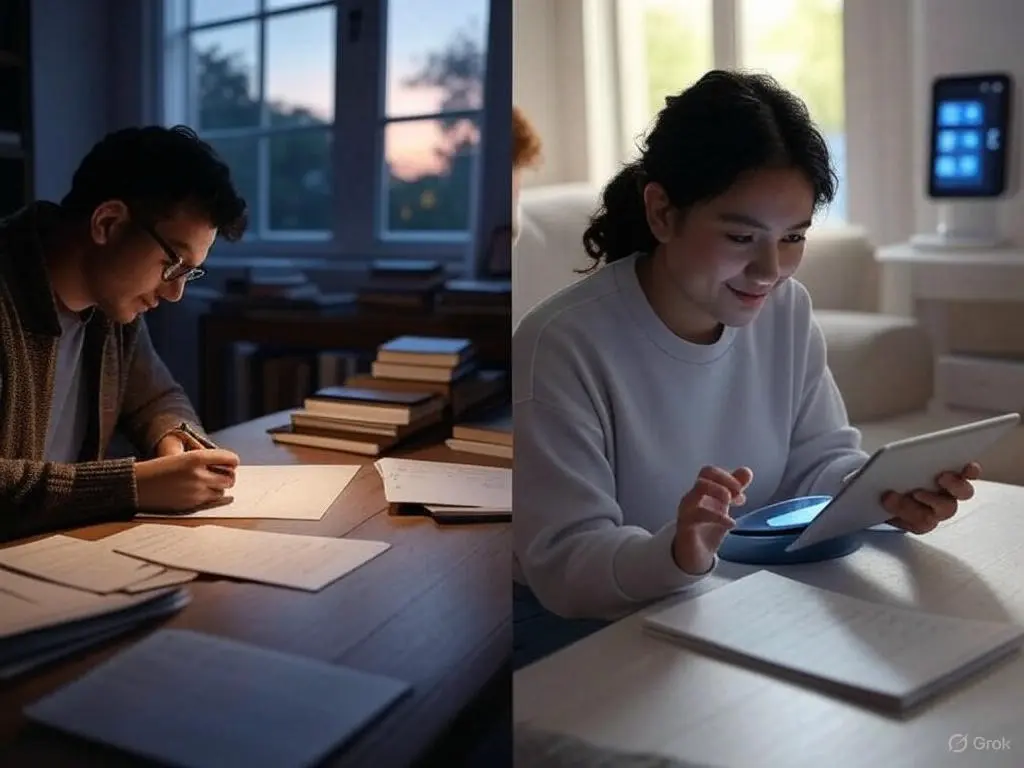Explore real-life examples of changes before and after AI innovation in shopping, healthcare, transportation, and more. Learn how AI transforms daily life, its benefits, challenges, and future trends.
Real-Life Examples of Changes Before and After AI Innovation
Artificial intelligence (AI) has changed the world in ways we never imagined. From shopping to healthcare, real-life examples of changes before and after AI innovation show how this technology makes life easier and smarter. But how exactly has AI reshaped our daily routines? This article highlights specific examples, benefits, challenges, and what’s next for AI.
What is AI Innovation?
AI innovation means creating smart systems that think and act like humans. These systems learn, solve problems, and make decisions. You see AI in tools like virtual assistants or self-driving cars. For a deeper look, check out MIT’s guide to AI.
Real-Life Examples of Changes Before and After AI Innovation
Real-life examples of changes before and after AI innovation span multiple areas of life. Here are five key examples:
Shopping and Retail
Before AI: Shoppers browsed stores or websites with no personalized suggestions. Finding the right product took time, and customer service was slow.
After AI: AI powers product recommendations, virtual try-ons, and chatbots. For example, Amazon uses AI to suggest items based on your browsing history, making shopping faster and more tailored.
Learn more about AI in retail from Forbes.
Healthcare
Before AI: Doctors relied on manual diagnostics, and patients needed in-person visits. Detecting diseases like cancer was slow and less accurate.
After AI: AI speeds up diagnostics and supports telemedicine. IBM Watson, for instance, helps doctors detect cancer early by analyzing medical data. Wearables like Fitbit track health in real-time.
The World Health Organization highlights AI’s healthcare impact.
Transportation
Before AI: People used paper maps or asked for directions. Driving was fully manual, and traffic jams were hard to avoid.
After AI: AI powers navigation apps like Google Maps and self-driving cars. Tesla’s autonomous vehicles use AI to navigate roads safely, reducing human error.
A study by IEEE shows AI improves road safety.
Customer Service
Before AI: Customers waited on hold or sent emails for support. Responses were slow, and help wasn’t always available.
After AI: AI chatbots provide 24/7 support. Zendesk’s AI-powered system answers questions instantly, improving customer satisfaction.
Explore AI in customer service at Reuters.
Education
Before AI: Learning was one-size-fits-all, with limited access to personalized resources. Students relied on textbooks and in-person classes.
After AI: AI offers tailored learning experiences. Duolingo uses AI to adjust language lessons based on your progress, making learning fun and effective.
Discover AI’s role in education from EdTech Magazine.
Benefits of AI-Driven Changes
Real-life examples of changes before and after AI innovation reveal several benefits:
- Efficiency: AI speeds up tasks like shopping or diagnostics.
- Accessibility: AI makes services like healthcare and education available to more people.
- Personalization: AI tailors experiences, from product suggestions to learning plans.
For instance, AI chatbots help small businesses offer better customer service, while AI health tools assist rural communities.
Challenges of AI Innovation
Real-life examples of changes before and after AI innovation also highlight challenges. Privacy is a concern, as AI collects personal data. Job displacement worries workers, as automation replaces some roles. Ethical issues, like biased AI systems, need addressing. The EU AI Act aims to ensure responsible AI use, per BBC.
The Future of AI Innovation
Real-life examples of changes before and after AI innovation point to an exciting future. AI could power smarter cities, enhance education with virtual tutors, or support mental health with personalized tools. Trends like AI for sustainability are growing. A McKinsey report predicts AI will drive major economic growth by 2030.
Conclusion
Real-life examples of changes before and after AI innovation show how AI has transformed shopping, healthcare, transportation, customer service, and education. These changes bring efficiency, accessibility, and personalization, though challenges like privacy remain. As AI evolves, its impact will grow. Try AI tools in your life and share your thoughts below!
FAQs
1. What are real-life examples of changes before and after AI innovation?
AI has changed shopping (Amazon recommendations), healthcare (IBM Watson), transportation (Tesla cars), customer service (Zendesk chatbots), and education (Duolingo lessons).
2. How has AI improved healthcare?
AI speeds up diagnostics, supports telemedicine, and powers wearables, making healthcare faster and more accessible, per WHO.
3. What are the risks of AI innovation?
AI raises privacy, job loss, and ethical concerns, but regulations like the EU AI Act aim to address them, as noted by BBC.
4. How does AI change transportation?
AI enables self-driving cars and navigation apps like Google Maps, improving safety and efficiency, according to IEEE.
5. Will AI innovation continue to transform daily life?
Yes, AI will likely advance education, sustainability, and smart cities, per McKinsey.Show in sidebar

